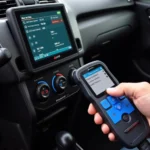In today’s tech-driven world, even diagnosing car problems has gone digital. Gone are the days of relying solely on mechanics’ intuition. Best automotive scan tools empower car owners and professionals alike to pinpoint issues with precision. Whether you’re a seasoned mechanic or a car enthusiast, understanding these tools can save you time, money, and unnecessary headaches.
Decoding the Power of Automotive Scan Tools
Automotive scan tools are essentially the interpreters between your car’s computer system and you. They plug into your vehicle’s OBD-II port (found under the dashboard) and read the Diagnostic Trouble Codes (DTCs) stored by the car’s ECU (Electronic Control Unit).
Think of DTCs as your car’s way of saying, “Hey, something’s not right here!” Instead of vague symptoms, you get specific codes that point towards the problematic system, whether it’s the engine, transmission, airbags, or emissions.
Types of Automotive Scan Tools: From Basic to Brainiac
1. Code Readers: The Entry-Level Essentials
As the name suggests, code readers primarily read and display DTCs. They are budget-friendly and perfect for DIY enthusiasts who want to understand basic car problems. However, they usually don’t offer in-depth diagnostic functions or the ability to clear codes.
2. OBD-II Scanners: The Versatile All-Rounders
These scanners go a step further than basic code readers. They not only read and clear DTCs but also display live data from the car’s sensors. This data includes engine RPM, coolant temperature, oxygen sensor readings, and more. OBD-II scanners are versatile tools suitable for both car owners and professionals.
3. Professional-Grade Scan Tools: The Diagnostic Powerhouses
These are the heavy hitters used by professional mechanics and dealerships. Professional-grade scan tools offer advanced functionalities like:
- Bi-directional control: This allows mechanics to interact with the car’s systems, like activating solenoids or running tests, to diagnose complex issues.
- Programming and coding: These tools can program new modules, update software, and perform key programming functions.
- Advanced diagnostics: They provide access to manufacturer-specific data, troubleshooting guides, and even repair information.
Choosing the Right Scan Tool: A Buyer’s Guide
With so many options available, selecting the right scan tool can feel overwhelming. Here’s what to consider:
- Your Skill Level: Are you a DIYer or a professional mechanic? Code readers are suitable for beginners, while professional-grade tools cater to experienced users.
- Vehicle Compatibility: Ensure the scan tool is compatible with your car’s make, model, and year. Some scanners are vehicle-specific, offering more in-depth diagnostics for certain brands.
- Features: Determine the features you need. Do you need live data streaming, bi-directional control, or coding capabilities?
- Budget: Prices can range from affordable code readers to expensive professional-grade tools.
- User-Friendliness: Opt for a scanner with an intuitive interface, clear navigation, and helpful resources.
The Future of Automotive Scan Tools: Embracing Smart Technology
As cars become increasingly sophisticated, so will the tools used to diagnose them. We can expect to see:
- Wireless Connectivity: Bluetooth and Wi-Fi-enabled scanners will allow for seamless data transfer and remote diagnostics.
- Cloud Integration: Cloud-based platforms will offer access to vast databases of repair information, diagnostic tips, and software updates.
- Augmented Reality (AR): Imagine using your smartphone or tablet to overlay diagnostic information onto a live view of your engine bay. AR has the potential to revolutionize how we diagnose and repair cars.
Conclusion: Empowering Car Owners and Professionals Alike
The evolution of best automotive scan tools has democratized car diagnostics, providing car owners and professionals with powerful tools to understand and address car problems efficiently. As technology advances, these tools will continue to become more sophisticated, intuitive, and indispensable for keeping our vehicles running smoothly.



